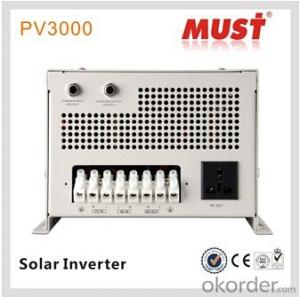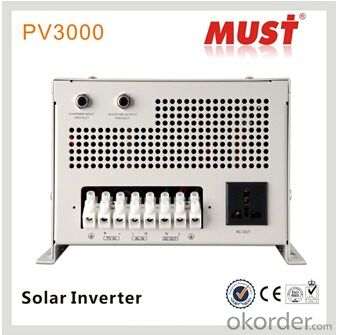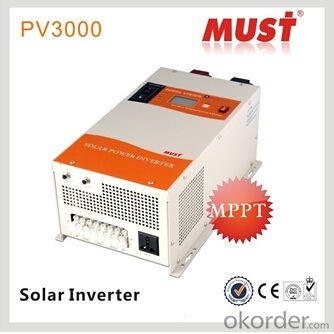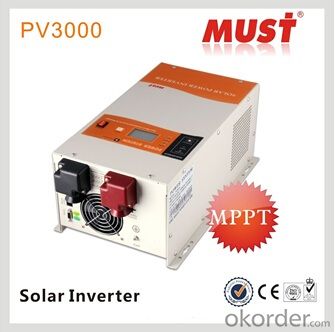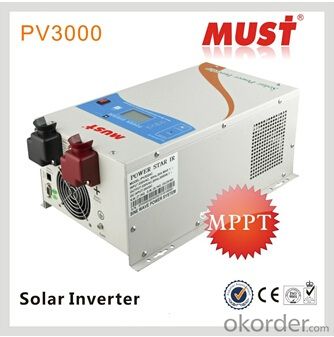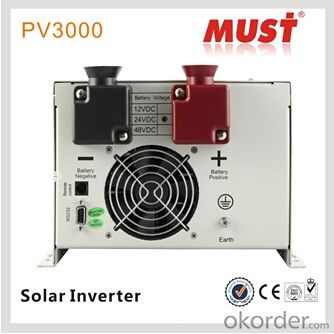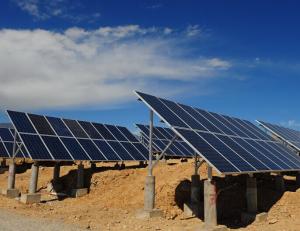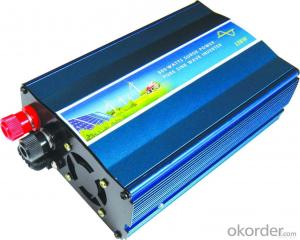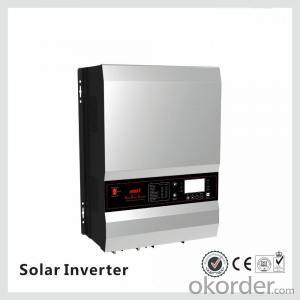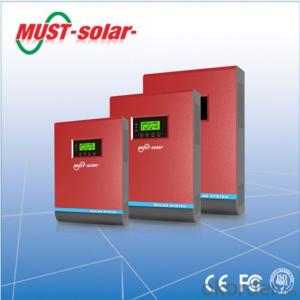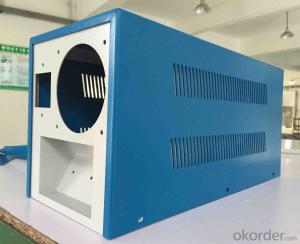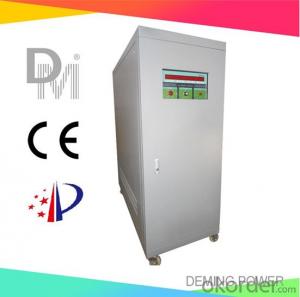Best Solar Inverter Off Grid - DC to AC Solar Power Charger Function Inverter
- Loading Port:
- China main port
- Payment Terms:
- TT or LC
- Min Order Qty:
- 100000 watt
- Supply Capability:
- 16000000 watt/month
OKorder Service Pledge
OKorder Financial Service
You Might Also Like
1. Structure of DC to AC Solar Power Charger Function Inverter Description
It is an electronic system that operates the photovoltaic(PV) modules in a manner that allows the modules to produce all the power they are
capable of. The solar mate charge controller is a microprocessor-based system designed to implement the MPPT. It can increase charge
current up to 30% or more compared to traditional charge controllers.
2. Main Features of the DC to AC Solar Power Charger Function Inverter
• Our inverter is designed AC priority by default. This means, when AC input is present, the battery will be charged first.
• When you choose battery priority(Battery type selector on 7-9), then inverter will invert from battery despite the AC input. Only when the
battery voltage reaches low voltage alarm point will be inverter transfer to AC input, charge battery and switch back to battery when the
battery is fully charged. This function is mainly for wind/'solar systems using utility power as back up.
3. DC to AC Solar Power Charger Function Inverter Images
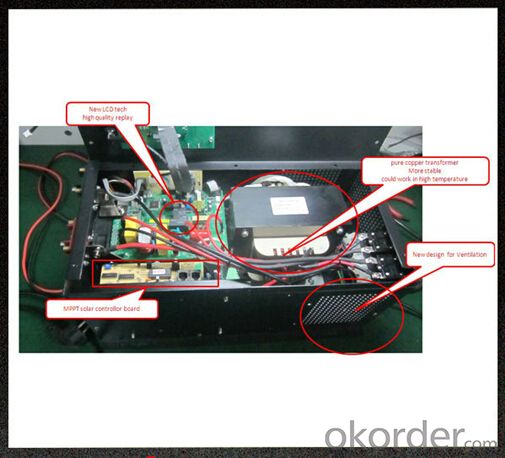
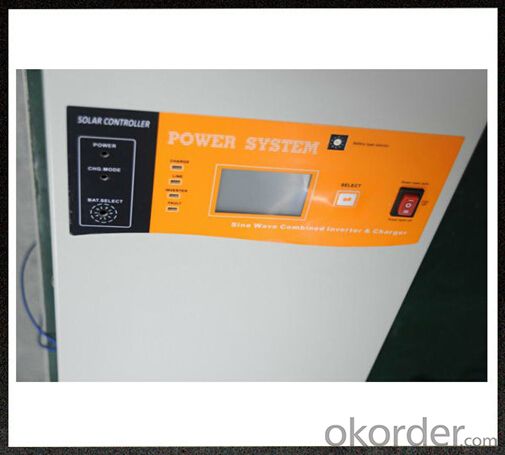
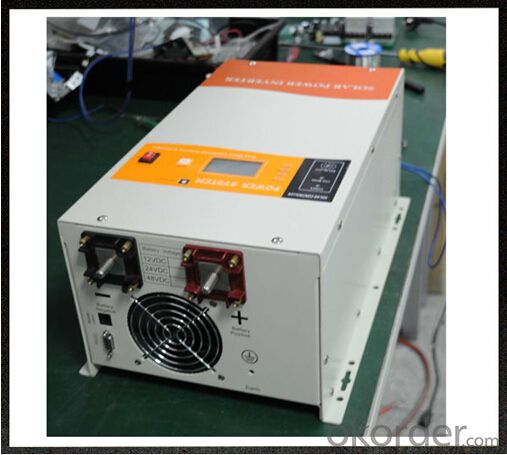

4. DC to AC Solar Power Charger Function Inverter Specification
Hybrid Inverter | ||
MPPT solar controller function | ||
Rated Voltage | 12/24V DC | |
Rated Charge current | 40A | |
Load current | 15A | |
Input voltage range | 15-55V DC | |
Max. PV open circuit array voltage | 55V DC | |
Typical idle consumption | At idle< 10mA | |
Overload protection(DC load) | 2.0*Inom>5s 1.5*Inom>20s 1.25*Inom temperature controlled | |
Bulk charge | 14.6V(default) | 29.2V(default) |
Floating charge | 13.4V(default) | 26.8V(default) |
Equalization charge | 14.0V(default) | 28.0V(default) |
Over charge disconnection | 14.8V | 29.6V |
Over charge recovery | 13.6V | 27.2V |
Over discharge disconnection | 10.8V(default) | 21.6V(default) |
Over discharge reconnection | 12.3V | 24.6V |
Temperature compensation | 13.2mV/C | 26.4mV/C |
Lead acid battery settings | Adjustable | |
NiCad battery settings | Adjustable | |
Load control mode | 1.Low Voltage Reconnect(LVR):Adjustable 2.Low Voltage Disconnect(LVD):Automatic disconnection 3.Reconnection:Includes warning flash before disconnect and reconnection | |
Low voltage reconnect | 12.0-14.0Vdc | 24.0-28.0Vdc |
low voltage disconnet | 10.5-12.5Vdc | 21.0-25.0Vdc |
Ambient temperature | 0-40°C(full load) 40-60°C(de-rating) | |
Altitude | Operating5000m,Non-Operating 16000m | |
Protection class | IP21 | |
Battery temperature sensor | BTS-optional remote battery temperature sensor for increased charging precision | |
Terminal size(fine/single wire) | #8 AWG | |
Solar inverter battery priority | |||||||
MODEL | 1000w | 1500w | 2000w | 3000w | |||
Input Voltage Waveform | Sinusoidal (utility or generator) | ||||||
Nominal Input Voltage | 230Vac | ||||||
Low Line Disconnect | 155Vac±4% | ||||||
High Line Disconnect | 265Vac±4% | ||||||
Max AC Input Voltage | 270Vrms | ||||||
Nominal Input Frequency | 50Hz/ 60Hz (Auto detection) | ||||||
Over-Load Protection | Circuit breaker | ||||||
Output Short Circuit Protection | Circuit breaker | ||||||
Efficiency (Line Mode) | >95% | ||||||
Transfer Switch Rating | 30A | ||||||
Transfer Time(Ac to Dc) | 20ms (typical) | ||||||
Output Voltage Waveform | Sine wave | ||||||
Rated Output Power (W) | 1000W | 1500W | 1500W | 2000W | 2000W | 3000W | 3000W |
Power Factor | 1 | ||||||
Nominal Output Voltage (V) | 230Vac | ||||||
Output Voltage Regulation | ±10% rms | ||||||
Nominal Efficiency | >80% | ||||||
Nominal DC Input Voltage | 12V | 12V | 24V | 12V | 24V | 12V | 24V |
Nominal Charge Current | 35A | 45A | 35A | 65A | 35A | 75A | 45A |
Charge Current Regulation | ± 5A | ||||||
Battery initial voltage | 0 –15.7 Vdc /31.4Vdc(can operate with 0V battery) | ||||||
Communication: | RJ11 (Used for factory testing. No customer interface available) | ||||||
Safety Certification | CE(EN60950) | ||||||
EMI Classification | EN50091-2, CLASS A | ||||||
Operating Temperature Range | 0°C to 40°C | ||||||
Storage temperature | -15ºC ~ 60ºC | ||||||
Operation humidity | 5% to 95% | ||||||
Audible Noise | 60dB max | ||||||
Cooling | Forced air, variable speed fan | ||||||
5. FAQ of DC to AC Solar Power Charger Function Inverter
Q1. What is the difference between inverter and solar inverter?
A1. Inverter only has AC inpput, but solar inverter both connect to AC input and solar panel, it saves more power.
Q2. What is the difference between MPPT&PWM?
A2. MPPT has higher efficiency, it can track the max power point and won't waste energy.
Q3. What is the waranty of product?
A3. 12 months.
- Q: How does a solar inverter handle voltage and frequency variations caused by grid faults?
- Grid support or anti-islanding function is the process by which a solar inverter manages voltage and frequency variations resulting from grid faults. It promptly detects disturbances, such as sudden drops or spikes in voltage or frequency, and responds accordingly. To address voltage variations, the solar inverter incorporates a voltage control mechanism. It continuously monitors the grid voltage and adjusts its own output voltage to match the grid level. In the event of a voltage drop or spike due to a grid fault, the inverter adjusts its output voltage to maintain a stable and secure operating condition. This safeguards both the solar system and the grid from potential harm. Similarly, the solar inverter handles frequency variations caused by grid faults. It constantly monitors the grid frequency and adjusts its own output frequency to align with the grid. If a grid fault results in a sudden frequency change, the inverter responds by adjusting its own frequency. This ensures the solar system remains synchronized with the grid and continues to provide uninterrupted power supply. Furthermore, solar inverters are equipped with anti-islanding protection. This feature enables them to quickly disconnect from the grid in the event of a grid fault. This safety measure prevents the solar system from supplying power to a faulty grid, thus minimizing risks to utility workers during repair. In summary, the solar inverter's capacity to handle voltage and frequency variations caused by grid faults is vital for the efficient and safe operation of a solar power system. By continuously monitoring and adjusting its output to match grid conditions, the inverter guarantees a stable and reliable power supply while keeping the solar system in sync with the grid.
- Q: Can a solar inverter be used in a solar-powered desalination system?
- Yes, a solar inverter can be used in a solar-powered desalination system. A solar inverter is responsible for converting the direct current (DC) electricity produced by solar panels into alternating current (AC) electricity, which is required to power the desalination system. By utilizing a solar inverter, the solar energy generated can be efficiently utilized to operate the desalination process, making it a sustainable and environmentally friendly solution for producing fresh water from seawater.
- Q: How does a solar inverter protect against power surges?
- A solar inverter protects against power surges by constantly monitoring the voltage and current levels of the solar panels and adjusting them accordingly. It has built-in surge protection devices that detect any sudden increase in voltage or current and divert the excess energy away from the solar panels, preventing damage to the system. Additionally, the inverter is equipped with advanced circuitry and protective components that can absorb and dissipate the excess energy, ensuring a stable and safe operation of the solar power system.
- Q: Are solar inverters compatible with battery storage systems?
- Yes, solar inverters are compatible with battery storage systems. In fact, solar inverters play a crucial role in integrating battery storage with solar power systems. Solar inverters convert the direct current (DC) electricity generated by the solar panels into alternating current (AC) electricity that can be used to power our homes and businesses. Battery storage systems, on the other hand, store excess solar energy for later use, allowing us to use solar power even when the sun is not shining. When combined with solar inverters, battery storage systems can be charged using the excess energy generated by the solar panels during the day, and then discharge that stored energy during the night or during periods of high energy demand. To facilitate compatibility, solar inverters used in battery storage systems are equipped with additional features and functionalities. For example, they may have built-in charge controllers that regulate the charging and discharging of the batteries, ensuring their optimal performance and longevity. Additionally, advanced inverters may also include smart grid capabilities, allowing them to communicate with the utility grid and optimize energy flows based on grid conditions and electricity prices. Overall, solar inverters are essential components in ensuring the seamless integration of battery storage systems with solar power, enabling us to maximize the benefits of clean and sustainable energy.
- Q: Can a solar inverter be used with a ground-mounted solar panel system?
- Yes, a solar inverter can be used with a ground-mounted solar panel system. The solar inverter is responsible for converting the DC power generated by the solar panels into AC power that can be used to power household appliances or fed back into the electrical grid. Whether the solar panels are mounted on the ground or on a rooftop, the inverter plays a crucial role in ensuring the efficient and effective utilization of the solar energy generated.
- Q: How does a solar inverter handle voltage fluctuations in the grid?
- A solar inverter handles voltage fluctuations in the grid by continuously monitoring the grid voltage. When the voltage exceeds or drops below the acceptable range, the inverter adjusts the power output of the solar panels accordingly. It stabilizes the voltage by regulating the flow of electricity from the solar panels, ensuring a consistent and safe supply of power to the grid.
- Q: What is the role of a solar inverter in preventing electrical hazards?
- The role of a solar inverter in preventing electrical hazards is to convert the direct current (DC) generated by solar panels into alternating current (AC) that is suitable for use in homes and businesses. By ensuring the safe and efficient conversion of power, solar inverters help to minimize the risk of electrical hazards such as electrical shock, fire, or damage to electrical appliances and equipment. They also incorporate safety features like ground-fault protection and overvoltage protection, further enhancing their role in preventing electrical hazards.
- Q: What is the maximum efficiency rating of a solar inverter?
- The maximum efficiency rating of a solar inverter can vary, but typically it ranges between 95% and 98%.
- Q: Can a solar inverter be used with electric vehicles?
- Yes, a solar inverter can be used with electric vehicles. Solar inverters are used to convert the DC (direct current) electricity generated from solar panels into AC (alternating current) electricity which can be used to power various devices, including electric vehicles. This allows for the charging of electric vehicles with clean and renewable solar energy.
- Q: Can a solar inverter be used with a solar-powered electric vehicle charging station?
- Yes, a solar inverter can be used with a solar-powered electric vehicle charging station. The solar inverter helps convert the direct current (DC) power produced by the solar panels into alternating current (AC) power that can be used to charge electric vehicles. This allows for efficient and sustainable charging of electric vehicles using solar energy.
Send your message to us
Best Solar Inverter Off Grid - DC to AC Solar Power Charger Function Inverter
- Loading Port:
- China main port
- Payment Terms:
- TT or LC
- Min Order Qty:
- 100000 watt
- Supply Capability:
- 16000000 watt/month
OKorder Service Pledge
OKorder Financial Service
Similar products
Hot products
Hot Searches
Related keywords
